I Took My 2 Children on a 12-day Cruise Around Northern Europe — and They Loved It
On a summertime sail around northern Europe, one intrepid family finds cultural pleasures, on and off the ship.
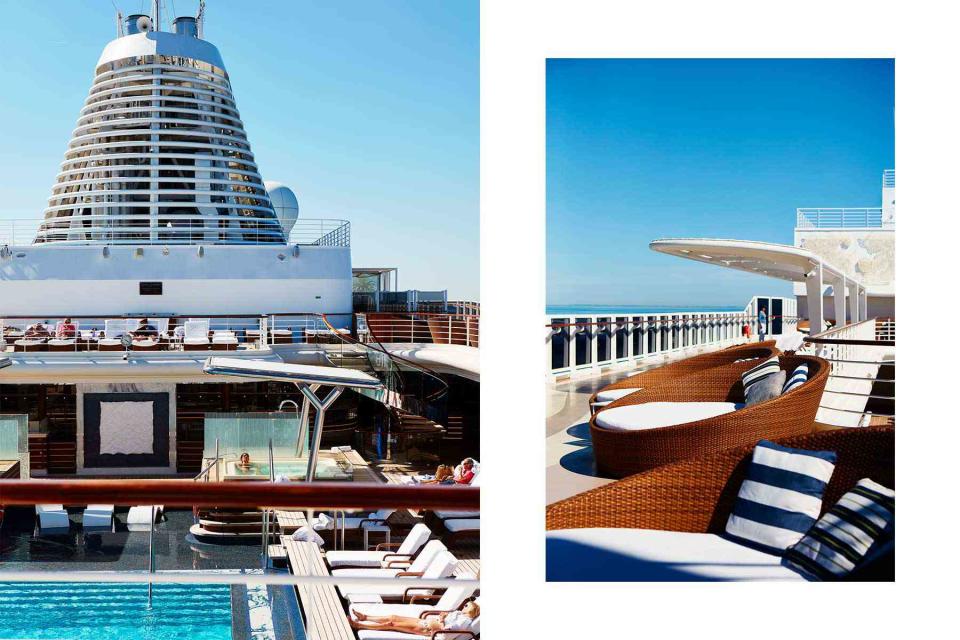
Yuki Sugiura
From left: Taking a break by the pool on the Splendor, the newest ship from Regent Seven Seas Cruises; sun beds on the Splendor’s pool deck.In 2018, my wife, Anne, and I took our two sons, Louis and Gabriel, on what we imagined would be our first and only cruise — a hastily organized six-day trip along the coast of Alaska. We had never considered ourselves cruise people, but Louis, then seven years old, had seen an animated movie set on an ocean liner and decided that a voyage on what he then called a “hotel-boat” was exactly what our family needed.
The hotel-boat on that trip did everything we might have hoped for — the short-duration excursions were both a break from the stress of raising two small children and an adventure for all of us. Four years later, as we considered another cruise — this time with two soon-to-be teenage boys — my wife and I wondered whether we could still handle the close confines of a ship, especially after two years of intermittent isolation. And even if we could, did we want to? Like many, we were desperate to step back into the world, yet also exhausted by thinking about the effort it might require to do so.
In the weeks leading up to summer, we studied a list of itineraries on Regent Seven Seas Cruises’ newest, most luxurious vessel, the Seven Seas Splendor. Completed in 2020, the ship was built to reflect Regent’s distinctive aesthetic — opulent, but understated, with an all-suites design, ensuring there were no crowded hallways, no awkward lines, no hovering for lounge chairs. As my family and I explored the Splendor’s amenities together, we joked about finally finding the hotel-boat Louis had dreamed of years earlier. It had everything we would have wanted in the perfect hotel — six restaurants, multiple lounges and bars, a library, a theater, a pool, and a spa — leaving us free to prioritize the very thing that had been missing from our lives for the past two years: the opportunity to see new places.
In the end we settled on a 12-day trip through the North Sea and the Baltic, securing a firm commitment from our children to spend as many hours as needed visiting museums in each place.
“Exactly how many museums are we talking about?” Louis asked.
I showed him the excursions we had arranged: three museums in Oslo; two in Tallinn, Estonia; one in Liepaja, Latvia; two in Helsinki, and at least four in the two days we had in Stockholm. Any hint of alarm vanished after I reminded him that our first two nights were spent entirely on board the ship once we departed from Southampton, England.
I had employed maps and guidebooks to research the numerous shore excursions included in the trip, then added my own list of very important places to see in each city. The value of that list began to diminish almost immediately, as we explored the comforts of the ship. On our first day at sea, we sailed past the White Cliffs of Dover while reading on the pool deck. My list suffered a fatal blow on our second evening when our sons met us outside the Compass Rose, the Splendor’s main restaurant, dressed in blazers and button-down shirts, excited at the prospect of having another multicourse meal with their parents.
“We’ve seen them every day for two years,” Anne said, “but somehow we didn’t notice they’d grown up.”
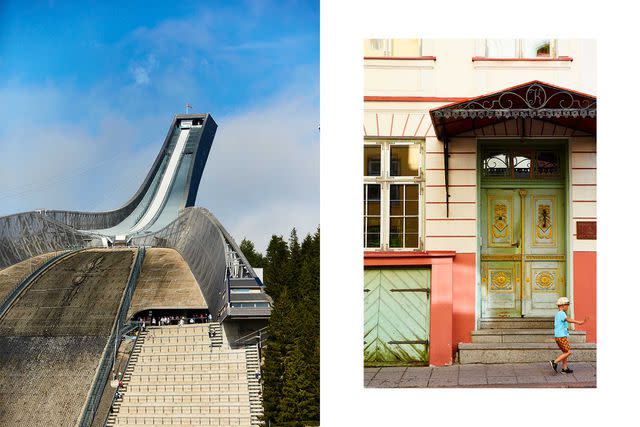
Yuki Sugiura
From left: Holmenkollen , a ski jump and museum north of Oslo, was a site of the 1952 Winter Olympics; a street in the Old Town of Tallinn, Estonia.The next day, as we approached Oslo, my wife suggested that perhaps we’d gone about this trip all wrong, and that we should have mapped out a game plan on board, as well. She pointed out that every evening, after we’d returned from a shore excursion, we could eat a wonderful dinner at the French restaurant, Chartreuse, watch a former West End star like Phillip Browne perform in the ship’s Constellation Theatre, and dance away whatever remaining energy we had in the Splendor Lounge.
After arriving in Oslo, we disembarked as soon as the ship docked and headed on our own to Grünerløkka, a once-working-class neighborhood along the Akerselva River. The area is now known for its trendy cafés and restaurants, vintage stores, and lively central square. When Louis and Gabriel asked us where we were going, we told them the truth: we had no plans, no single destination other than finding something interesting.
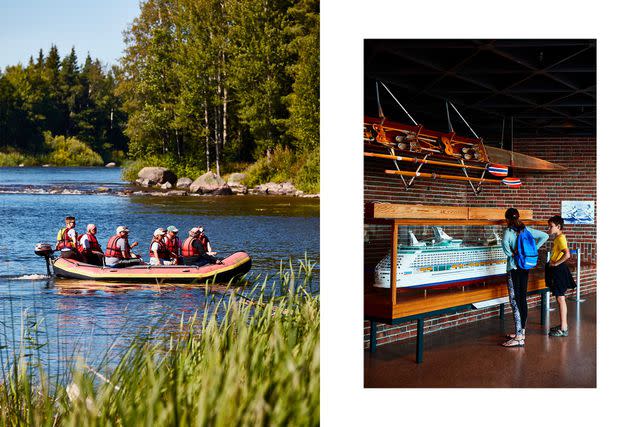
Yuki Sugiura
From left: Passengers on an excursion on Finland’s Kymi River; exploring Oslo’s Norwegian Maritime Museum.Over the course of a couple of hours we fell in love with two thrift stores, a coffee shop, and the views of the Nedre waterfall from the banks of the Akerselva, before taking a guided tour of the city’s maritime museums. Later, back aboard the ship, we had just enough time to swim in the pool and soak in the hot tub before sitting down to dinner at Sette Mari, the Italian restaurant where everyone, from the waiters to the hostess, knew our family by name.
During dinner, sailing toward Tallinn, we decided we wanted even more of that sense of the discovery from the morning.
Over the course of the next seven days, more came to mean a dozen different things. In Tallinn, it meant discovering the beautifully designed and unexpectedly moving Estonian Health Museum, where the transformation of the human body from birth to death is mapped out with an elegance and candor that felt as revelatory for Anne and me as it did for our children. Later, we had lunch in the center of Tallinn’s medieval old town while debating which of the two dozen museums near us we should go to next.
“KGB museum, city museum, art museum, marzipan museum,” we asked them.
“Is no museum an option?”
On most trips, Anne and I might have told them no, but Tallinn was different. It had the district called the Telliskivi Creative City, just on the other side of the old city walls. When we suggested it as an alternative, Louis and Gabriel were skeptical — they pointed out that creative district sounded suspiciously like museum district. “It’s not,” I promised them. “It’s much, much cooler.”
Any doubts they had about their parents’ understanding of cool vanished, at least temporarily, as soon as we entered the neighborhood. Rather than the Gothic architecture of a medieval town, we found a network of galleries, outdoor art exhibitions, markets, restaurants, and pubs, built partially out of recycled shipping containers, which Louis described as the kind of place he and his friends would build if they were in charge.
Two days later, we arrived in Helsinki. We found more in the central market in the Latvian port of Liepaja and during an unforgettable dinner of foie gras gyoza and miso black cod at the Splendor’s pan-Asian restaurant, Pacific Rim. In Finland, more meant wandering around the Kallio district early in the morning until we discovered a café with croissants that rivaled our favorite bakery in Paris.
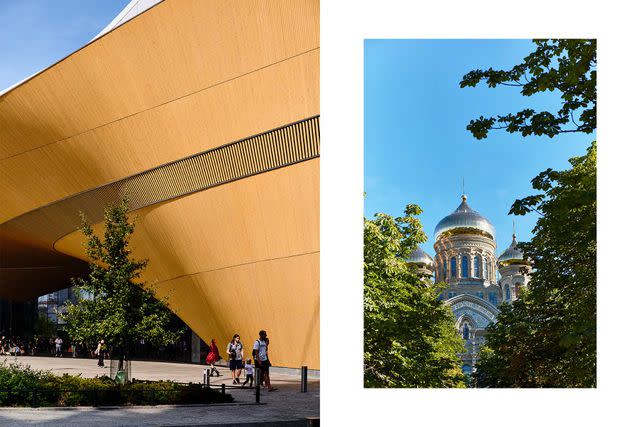
Yuki Sugiura
From left: Helsinki’s spruce-clad Oodi Library; the gilded domes of St. Nicholas Naval Cathedral, in Liepaja , Latvia.While we sat outside on a wide, tree-lined avenue, I asked the kids half-jokingly if perhaps we hadn’t already seen enough of the city. As it turned out, they had decided to take advantage of their suddenly lax parents and made their own list of things to do while in the Finnish capital. There was a Lego store that had to be visited, a food market that sold reindeer hot dogs, and — maybe as a consolation to their parents — the Kamppi Chapel, which, according to Gabriel, resembled a spaceship.
When Anne suggested we throw in the nearby Amos Rex, a fine arts institution founded by Finnish publisher and collector Amos Anderson, it was impossible to say no. The city-center museum, which was completed in 2018, consists of above- and belowground portions. The underground annex’s roof, we soon discovered, rose in undulating waves of concrete that begged to be climbed.
That evening, we offered Louis and Gabriel what we assumed was a respite from a long day with their parents.
“You can have dinner and watch a movie in the room,” I told them.
But they refused. There were people they needed to see, guests and staff they wanted to talk to. There was Maggie, who had been our waitress at Compass Rose and Sette Mari; the family from Dubai we played pickleball with in the afternoons; and the waiter in the Meridian Lounge.
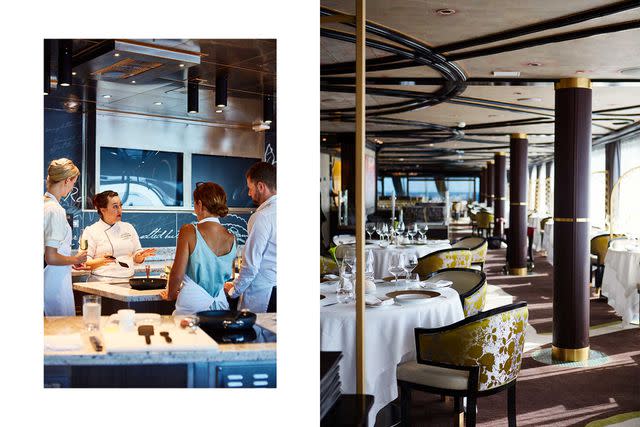
Yuki Sugiura
From left: A cooking class in the Splendor’s Culinary Arts Kitchen; Chartreuse, the ship’s French fine-dining restaurant.Later that night, as Gabriel whispered a secret dinner request to our server at Chartreuse and Louis decided that this was the moment to finally try escargots, I was reminded of a conversation I’d had with Franck Galzy, the Splendor’s general manager, about the culture aboard the ship. I’d mentioned to him that, as fond as we were of the pool and spa, that wasn’t what had made coming back at the end of each day so special. Galzy has been with the Splendor since its 2020 launch and spends half the year on board. He understood exactly what I meant before I could finish explaining.
“We say it’s a big family, because for us it is,” Galzy said. “That’s how we treat each other. It’s how we treat our guests.”
By the time we neared Stockholm, we had rafted down a river in Kotka, on the Gulf of Finland, driven through the remnants of a Soviet military base in Latvia, and watched the last supermoon of the year rise above the Baltic Sea. After each excursion, Anne and I had ended our evenings with drinks in the observation lounge at the bow of the ship and a toast to the days ahead.
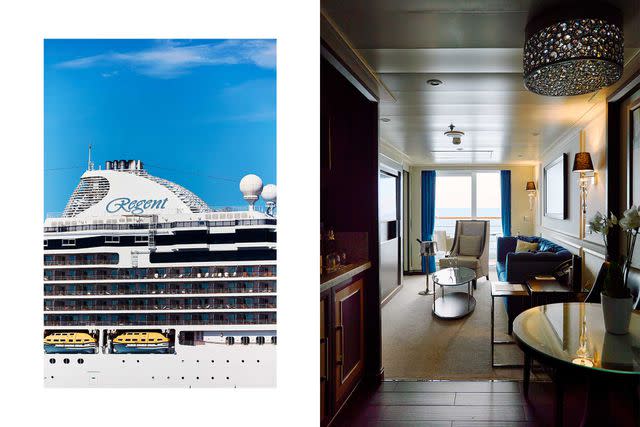
Yuki Sugiura
From left: Each of the ship’s 366 suites has a balcony; a Penthouse Suite entryway and living room.Gliding into Stockholm, we marveled at the view of the archipelago at sunrise from our balcony, while doing our best not to acknowledge the limited time we had left and savoring these rare moments alone as a couple. Just before disembarking, I couldn’t help making one final list of all the important things that I thought we needed to see: there was Fotografiska, the museum of photography; the Nobel Prize Museum; the Opera House; the National Library of Sweden; the Modern Art Museum; and the Royal Palace.
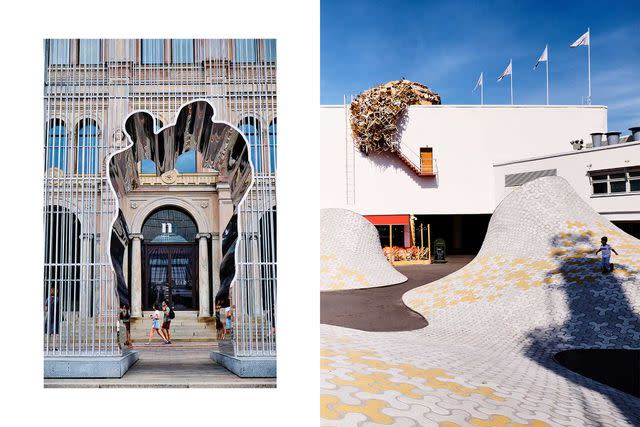
Yuki Sugiura
From left: The painting-and sculpture-focused Nationalmuseum, in Stockholm; the Amos Rex museum, in Helsinki.“We’re running out of time,” I told Anne, as I showed her the list. Having seen our children seemingly transformed overnight, she understood better than anyone why I’d made it. She pointed out the obvious — list or no list, there would never be enough time.
Over the next two days, we did our best not to forget that. We spent more than an hour on a single exhibition at Fotografiska, and another half-hour taking family portraits in a photo booth. We stumbled into a used-comic book shop on an impossibly narrow street in the old town, then sat in the shadow of the Royal Palace eating ice cream.
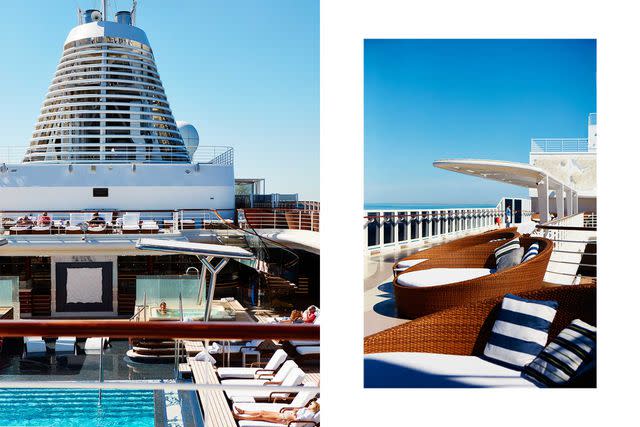
Yuki Sugiura
From left: Taking a break by the pool on the Splendor, the newest ship from Regent Seven Seas Cruises; sun beds on the Splendor’s pool deck.By the time we returned to the Splendor at the end of our first day in Stockholm, we had walked aimlessly for miles, just as we’d hoped and planned. The next evening we would leave for Visby, Sweden, our last destination before disembarking in Copenhagen. But before then, there was the barbecue on the pool deck the staff had spent the day organizing. It would be the most memorable meal we’d have, in no small part because we would get the chance to say thank you and goodbye to everyone who had made our time on board so memorable. As we raced back to get a poolside seat for dinner, Gabriel reminded us that we had only two more nights left on our hotel-boat.
“It’s important,” he said, “that we make the most of it.”
Regent Seven Seas Cruises offers similar 12-day London to Copenhagen sailings from $15,099 per person, all-inclusive.
A version of this story first appeared in the December 2022/January 2023 issue of Travel + Leisure under the headline "Days of Wonder."
For more Travel & Leisure news, make sure to sign up for our newsletter!
Read the original article on Travel & Leisure.

